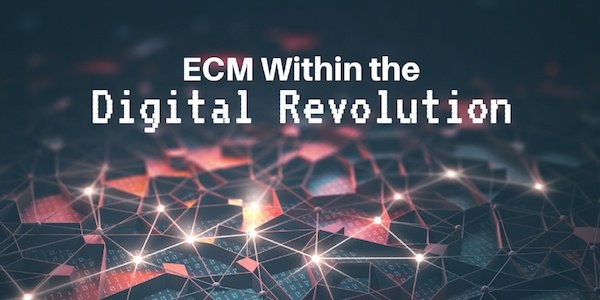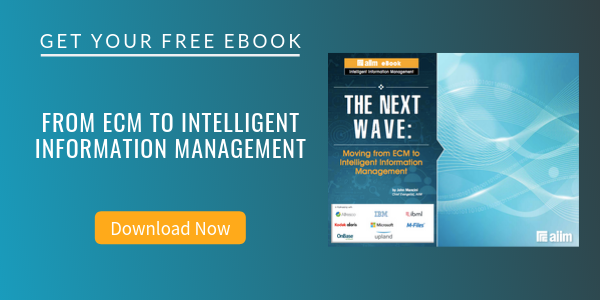
Digital Transformation and the Role of ECM (or Whatever We Wind Up Calling It!)
Enterprise Content Management (ECM) | Digital Transformation
Digital is changing people and organizations, not only in terms of technological opportunities, but also in how people think about technology and its role in their lives. It’s no longer people who adapt to technology – rather, technology adapts to us.
The digital wave has set new standards for the world, and it will do the same for ECM. ECM’s user requirements, information approach, business cases, sponsors, architecture, and even the existence of the term “ECM” is challenged.
So, what kinds of changes can we expect in how we work and the role of ECM in the face of this digital wave? Here are seven to consider:
1. ECM will continue to play a key role in digital transformation.
Almost all digital transformations are connected in some fashion with ECM. For example, intelligent automation is now enabling the organization of data and workflows in a way humans could have never imagined. Developments in artificial intelligence will continue to irrevocably change the human interaction with information, as many examples of IBM’s Watson technology are already displaying. And unstructured data needs to cross boundaries: digital leading companies are creating digital ecosystems, creating open standards and APIs, enabling them to leverage it in a way that brings the most value to them.
2. The future is all about appification.
People are willing to install apps, customize them, and use them because they work for them. In most cases, people are impartial to where their information resides and how it’s managed. But they tend to care greatly about how it can be customized for their use. The innovation of collaboration tools is driven by this principle. Tools like Slack, Trello, and Workplace are supplying information anywhere, anytime in a collaboration- and user-centric fashion. The ongoing blurring of boundaries of one’s professional and personal life also demands information to be always available on a device people use at home.
3. Information security has never been more important than now.
Information security is paramount to most people, and thus, information security is now driving business cases more than ever. Hilary Clinton’s suitability for becoming president was not challenged because her employee productivity was low (which is one of the old school ECM business case drivers), but because of her security protocol.
4. We will need to deal with many more forms of unstructured content.
Facebook is predicting video will be the main way to share information, and organizations will follow as the workforce exists out of the people who are following this trend in their private lives.
5. Information will continue to grow, and information management will continue to splinter.
The main challenge faced by organizations is the spread of information on different information silos. After file shares, organizations installed ECM solutions, but the file share was conserved. After that, organizations implemented ECM suits, but separate solutions were not always removed. Recently organizations are moving more and more to collaboration solutions and will move to the cloud. An organization-wide overview of all unstructured data repositories is often more scary than comforting.
6. Governance will grow more complicated.
As new collaboration apps, channels, and networks are connected to the organization; governance is more complicated than ever. In addition, compliance rules and regulations are increasing with FRCP and GDPR, as well as the expectation of users that companies safeguard their information. Organizations will find it challenging to prove the value of information. They cannot find it, and when they’ve found it, there is often no method to classify it as valuable. An interesting trend to consider the growth of temporary information. Snapchat is the ultimate user example, but there are clear examples within organizations where information is created for single use. This means more information to search through and more invaluable information.
7. Last but not least is ECM user adoption.
This is no news to whoever reads this but important to note, looking at the new possibilities that put the user in the center of solutions. The good news is that the Digital Revolution is not only disrupting ECM but is bringing solutions along.
Consider How This Hypothetical Employee Works
 This guy gets up in the morning, and while he is sitting on the toilet maintaining his WhatsApp, he gets a notification via his employer's mobile app. He opens it and sees he needs to pull together a complete legal overview of an important client, and opens a Spotify-like app. Here he browses through ERP and Salesforce data as well as all client-related documents from SharePoint, the company’s file share, and Open Text records management. He kisses his hipster girlfriend goodbye and Ubers to the train, where he continues working on his IPad and sends a draft version to a colleague who is already behind her laptop (decorated with cool stickers) at work. Arriving at work, they pull everything on an interactive whiteboard where they make last-minute changes with their boss.
This guy gets up in the morning, and while he is sitting on the toilet maintaining his WhatsApp, he gets a notification via his employer's mobile app. He opens it and sees he needs to pull together a complete legal overview of an important client, and opens a Spotify-like app. Here he browses through ERP and Salesforce data as well as all client-related documents from SharePoint, the company’s file share, and Open Text records management. He kisses his hipster girlfriend goodbye and Ubers to the train, where he continues working on his IPad and sends a draft version to a colleague who is already behind her laptop (decorated with cool stickers) at work. Arriving at work, they pull everything on an interactive whiteboard where they make last-minute changes with their boss.
Why do we need to pay attention to him? He represents how work is increasingly done. Translating this into what an organization needs to do to make this happen touches upon the key trends and technological opportunities for information management.
What Does This All Mean for ECM (or Whatever We Call It) in the Future?
Our hypothetical employee has a vendor-agnostic and app-centric view of the world.
- He wants to use an app spanning over multiple repositories.
- The information displayed is metadata based.
- This metadata was added by automated intelligent classification, and content analytics informed the app on to show the most valuable documents first for the type of legal search he performed.
- The app combined structured and unstructured data into a usable form, transportable to other devices.
- The app kept track of which data he used, so in the next search, that data is more likely to be displayed. He did not have to retrieve the information from systems he did not choose to work with; he used a personalized, customizable app that brings this information to him.
- And the cloud made all these transactions fast, live, and secure.
- Information Management plays an over-layering role, integrating the history and present of how unstructured data is managed.
- And this guy has friends. Friends who have other client journeys. Someone who is a consumer and wants to use his right to see all the information a company is storing on this person. Or someone who is an insurance customer and wants to know if his damage is covered.
This is what ECM needs to be about. It is what the consumer of today is expecting. It is what the employees of the future will expect. It’s not scary; it’s just a new way of putting our information management skills to work.



